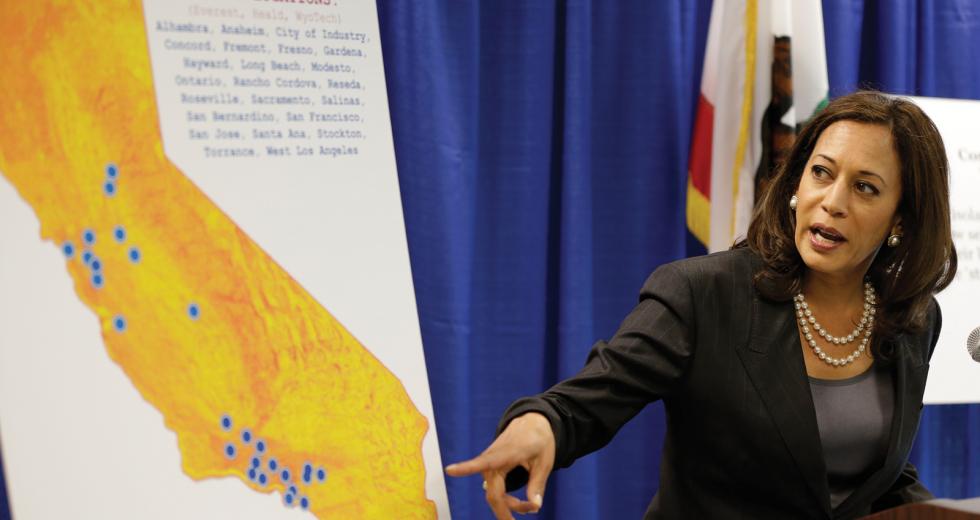For decades, politicians and journalists have released reports showing the sector taking a disproportionate share of federal financial aid dollars (a quarter of the total allotment, by one count) and producing a disproportionate number of students who default on their loans. The critic’s interpretation: The job training at these schools must be weak, if not downright fraudulent.
It didn’t take long for the for-profit colleges to get back in the news. Just a year after Senator Tom Harkin (D-Iowa) dropped a massive report accusing for-profits of overcharging students for worthless degrees, California Attorney General Kamala Harris set her sights on Corinthian Colleges Inc. The operator of Heald, Everest and Wyotech colleges piled debt on poor young people while falsely promising quality education and job opportunities, alleged the AG in an October lawsuit. Harris went on to describe Corinthian’s “predatory scheme” as “unconscionable.”
Are for-profit colleges truly one of Capitalism’s hideous deformities? For decades, politicians and journalists have released reports showing the sector taking a disproportionate share of federal financial aid dollars (a quarter of the total allotment, by one count) and producing a disproportionate number of students who default on their loans. The critic’s interpretation: The job training at these schools must be weak, if not downright fraudulent.
The findings have produced waves of regulations over the entire industry. New rules were passed a couple years ago, and more are on the way. But just like community bankers complain about Wall Street’s Goliath banks tarnishing their reputation, for-profit college representatives feel similarly scapegoated.
“Enough is enough,” says Robert Johnson, executive director of the California Association of Private Postsecondary Schools. “You’ve gotten to the point now where it’s overkill. Other states are regulated, but they look at what we have and it’s just over the top.”
For-profit institutions, and the government regulations placed on them, strike a deep American nerve because the schools are vulnerable to attacks by both liberals and conservatives. By focusing on privatization, the schools would seem to be a free-market jobs program. But they rely almost entirely on government subsidies. Nationwide, the sector took in $28.4 billion of federal aid in the 2010-2011 academic year, according to the U.S. Department of Education. The average for-profit school takes more than 80 percent of its revenue from federal aid.
The U.S. has long struggled with the idea of higher education as a right, and problems resulting from privatization are met with natural scrutiny. It’s a complicated issue, because for every media or government report that publishes scandalous data about extremely high default and dropout rates, the industry argues that the numbers are the inevitable result of educating an at-risk population. Poor people drop out of college or stop paying their loans for a host of reasons outside of a college’s control, they say.
“Default has no relationship to quality of education or whether or not a person is working,” says Johnson. “There’s no facts to back that up. None. It could be many things. It could be quality of education. Who knows? But to say that’s the absolute reason drives me wild.”
For-profit colleges have been around for more than 150 years but saw a large influx at the turn of the 20th century when droves of working class people matriculated into high school. In the 1960s, the civil rights movement drove the country’s education establishment to embrace a ‘college for all’ philosophy. That trend, combined with President Lyndon Johnson’s War on Poverty, paved the way for the federal Higher Education Act of 1972, which opened Pell grants and other financial aid programs to students attending for-profit schools.
The law expanded the number of for-profits across the country by 11 percent each year. From 1976 to 2006, for-profit institutions went from a 0.4 percent share of the total U.S. higher education market to 6 percent.
From early on, the sector targeted working class adults — single mothers, veterans, college dropouts, even former gang bangers. The students were often young parents who wished to ascend toward a career. For-profit schools have long capitalized on this market because, unlike public colleges, proprietary colleges can offer more specialized training, flexible course times and, in the past decade or so, a variety of online classes.
In the late 1980s, the federal government caught wind of disproportionately high default rates in the for-profit sector, and began denying financial aid to schools with default rates over 25 percent. That rule dropped the number of for-profit schools operating in the U.S. by a quarter. Years later, however, officials realized that some schools were using accounting gimmicks to misrepresent their numbers, so the rules were tightened in 2008. The impact of that reform is still being monitored and success won’t be known until 2014.
Meanwhile, the for-profit sector continues to be the subject of investigative exposés. A Bloomberg investigation found top executives at the 15 publicly-traded for-profits pocketed $2 billion in pay and stock sales while clocking the worst loan-default and four-year college dropout rates in the entire U.S. higher-education sector.
In August 2010, The Government Accountability Office released a report and accompanying video of 15 for profit colleges that showed college recruiters exaggerating the salaries available to students who had gone through their program, lying to students about a school’s accreditation and encouraging student’s to lie on government forms to maximize student loans. The GAO later backed off some of its claims but stood by its accusation of widespread fraud.
Closer to home, a 2010 analysis by the Sacramento Bee found that for-profit schools in the Capital Region educated one eighth of college students but were responsible for two thirds of the region’s student loan defaults.
Under pressure to implement more regulations, in 2011 the federal government tightened rules around recruitment tactics and increased the kinds of disclosures schools must make.
In California, lawmakers created eligibility criteria for the Cal Grant, which is financed by the state general fund. The criteria has changed since it first went into effect, but schools are currently denied the Cal Grant if more than 15.5 percent of their students default on their loans or if their graduation rate is less than 30 percent. This year, 114 for-profit schools didn’t make the cut, and 51 did.
“In California now we have a strong system of licensure and approval and oversight,” says Diana Fuentes-Michel, executive director of the California Student Aid Commission. “It’s not perfect,” she adds. “My colleagues will argue that a 30 percent graduation rate is nothing to write home about. But we have a place to start. Before, we didn’t have anything.”
The state and federal government plan to go even further by strengthening the so-called ‘triad’ of accountability: the federal government, the state government and accrediting institutions, which can be regional or national.
Federal officials are developing a new metric to gauge a student’s ability to find work and repay loans. California lawmakers also plan to reauthorize the state bureau and their accountability regulations in 2014. Industry practitioners fear the piling on of onerous compliance paperwork.
“If you look at federal standards, accreditor standards, state standards — none of them line up. Placement rates don’t line up, completion rates don’t line up, because they are all defined a little differently,” says Johnson. “We have three standards that we’re reporting. No other sector of education does that.”
But supporters of the new rules argue the additional oversight is needed to protect against a sector with a troubled track record. “Too many students are taking out loans to go to colleges that may not give them what they bargained for. We need more information and transparency for consumers and more accountability for colleges. When colleges fail to deliver, they need to be cut off,” says Debbie Cochrane, research director for the Institute for College Access and Success.
If part of this effort is to crack down on obscene profiting by college presidents, the abuse is not apparent inside John Zimmerman’s office. The president of MTI College in Sacramento apologizes for the stacks of small cardboard boxes piled along his wall, leaving little room for a guest. The office sits above a classroom full of stylist chairs and sinks at the college’s Paul Mitchell beauty school.
The irony of government regulations and his industry’s aversion to them is that they’ve made MTI “a far better institution today than we were in 1980,” Zimmerman says.
Back then, when Zimmerman’s father ran the college, MTI would open the doors to any student. The college’s student loan default rate was 28 percent. “Nobody cared,” he remembers. “Access to education should be available to all, that was the mantra. Let everyone have an opportunity.”
But in the past few decades, the college grew more selective with its enrollment policy. Educators began focusing more on test results to identify common deficiencies to raise class-wide achievement. It’s worked. According to Zimmerman, MTI now boasts a 91 percent placement rate and 71 percent graduation rate.
The regulations may have improved instruction and performance, but there is one issue they don’t address. With the focus now on student outcomes, what becomes of that applicant pool that the sector is no longer willing to accept? Community colleges are over capacity, public and nonprofit universities require good grades. There is a leftover student population that for-profits used to take a chance on. Not anymore.
“I’m not serving those people because I can’t afford to serve them. It’s going to come back and shut us down,” says Zimmerman. “No school in their right mind, even any public school, would want to open up and serve the hard-to-serve people because they know what the outcomes are. So who is going to serve these people? Are we in a perpetual cycle of people being pushed aside and no one taking care of them?”
Allen Young is the associate editor of Comstock’s magazine. Reach him at ayoung@comstocksmag.com or follow him on Twitter @allenmyoung.
Recommended For You

Study Abroad
Placer County goes global in search for higher education
A 12-year mission to bring higher education to Placer County, spearheaded by local land baron Angelo Tsakopoulos, has gone global.




